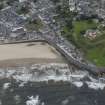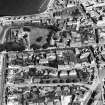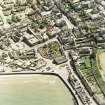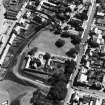Banff, Church Street, St Mary's Church And Burial-ground
Burial Aisle (16th Century), Burial Ground (Medieval), Church (Medieval)
Site Name Banff, Church Street, St Mary's Church And Burial-ground
Classification Burial Aisle (16th Century), Burial Ground (Medieval), Church (Medieval)
Alternative Name(s) Carmelite Street; High Shore; Ogilvie Burial-vault; Old Parish Church
Canmore ID 18476
Site Number NJ66SE 42
NGR NJ 69048 64056
Datum OSGB36 - NGR
Permalink http://canmore.org.uk/site/18476
- Council Aberdeenshire
- Parish Banff
- Former Region Grampian
- Former District Banff And Buchan
- Former County Banffshire
NJ66SE 42 69048 64056
(NJ 6903 6404) Church (NR)
OS 6" map, (1960)
The old church of Banff, dedicated to St Mary, was erected in 1471 and demolished in 1797 leaving only a south aisle.
Name Book 1867; A Ramsay 1886.
All that remains of St Mary's Church is the so-called south aisle, which is a burial vault of the Ogilvies containing 16th century graves and part of the N wall, incorporating grave-slabs erected before 1797, when the church was mostly demolished. The graveyard is disused.
Visited by OS (NKB) 1 February 1968.
NJ 6903 6404 A project for the restoration and conservation of the Banff (Ogilvie) Aisle made provision for limited archaeological observation and excavation to lower and level the ground both inside and outside the aisle. The work was carried out in March and June 2003.
No archaeological features or finds were evident during the lowering of the exterior ground level. However, reduction of the 20th-century floor level within the aisle exposed the lowest detail of the Ogilvie tomb. It was evident that the interior ground level was made up, to a depth exceeding 0.75m, by using material from the late 18th-century landscaping of the surrounding graveyard. This fill contained small amounts of disarticulated human bone and a single coin - a copper turner or twopence of Charles I, dated between 1642-50. Above this, a hard-packed layer of black sandy clay formed the floor level, with reused red sandstone slabs placed beneath the columns of the tomb and in front of the doorway into the aisle.
Archive to be deposited in the NMRS.
Sponsor: Aberdeenshire Historic Kirkyards Project.
J C Murray 2003
NJ66SE 42 69048 64056
EXTERNAL REFERENCE:
The National Library of Scotland, Edinburgh
This archive holds the following records of the Mediaeval Church at Banff:-
'Uncatalogued MSS of General Hutton, and numbered 29, Vol.II, a Plan of the old Church at Banff, to the scale of half inch to ten feet, by Wm. Hay: and a coloured Sketch of a Monument to Sir Walter Ogilvy.
It seems that, according to the A.A. Roadbook of Scotland, 1938, all that is left of the medieaval Church is the vaulted burial Aisle of the Ogilvies behind the Post Office.' (1950)
Photographic Survey (August 1965)
Photographic survey of buildings in Banff by the Ministry of Works/Scottish National Buildings Record in August 1965.
Publication Account (1977)
What is perhaps the first reference to Banff parish church occurs in a charter of Matthew, Bishop of Aberdeen, to the ,monastery at Arbroath in the late twelfth century, a grant confirmed by Pope Innocent ID in 1200 (Cramond, 1893, 12). The church occupied a site on level ground which stretches southwards from the castle towards the shore. It is reputed to have been rebuilt in 1471 (Smith, 1894-96, 124). The church was described as being in a ruinous way in 1749 and the bell and clock were removed shortly thereafter in 1761. A new parish church was built in the High Street in 1789-90, with the old structure being demolished in 1797. Fragments of the latter building still survive. The south aisle containing the tomb of Sir Walter Ogilvy remains, along with a small part of the north wall of the nave to which is affixed a monument to the Bairds of Auchmedden. A fine collection of seventeenth-century headstones litter the graveyard.
Information from ‘Historic Banff: The Archaeological Implications of Development’ (1977).
































































































































































































